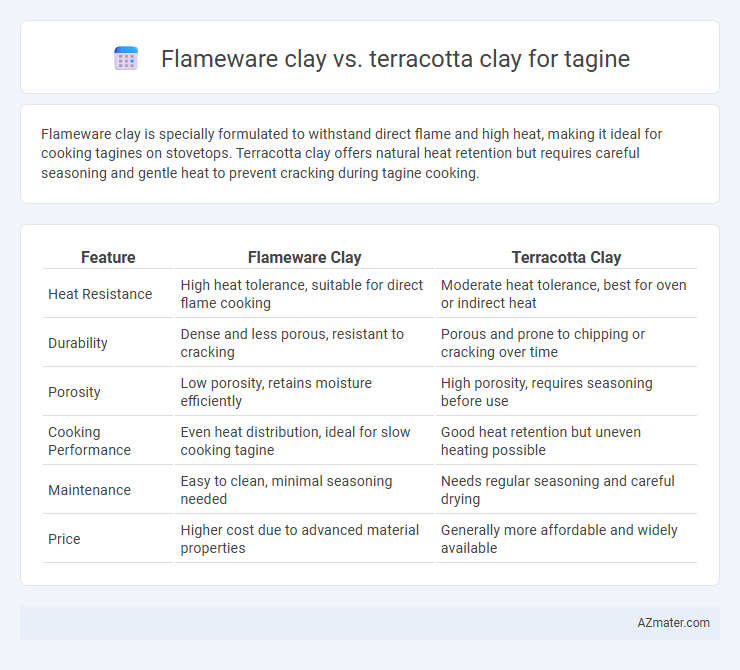Flameware clay is specially formulated to withstand direct flame and high heat, making it ideal for cooking tagines on stovetops. Terracotta clay offers natural heat retention but requires careful seasoning and gentle heat to prevent cracking during tagine cooking.
Table of Comparison
| Feature | Flameware Clay | Terracotta Clay |
|---|---|---|
| Heat Resistance | High heat tolerance, suitable for direct flame cooking | Moderate heat tolerance, best for oven or indirect heat |
| Durability | Dense and less porous, resistant to cracking | Porous and prone to chipping or cracking over time |
| Porosity | Low porosity, retains moisture efficiently | High porosity, requires seasoning before use |
| Cooking Performance | Even heat distribution, ideal for slow cooking tagine | Good heat retention but uneven heating possible |
| Maintenance | Easy to clean, minimal seasoning needed | Needs regular seasoning and careful drying |
| Price | Higher cost due to advanced material properties | Generally more affordable and widely available |
Introduction to Tagine Cooking
Tagine cooking traditionally relies on terracotta clay, prized for its porous nature that allows slow, even heat distribution and moisture retention, essential for developing rich, deeply infused flavors. Flameware clay offers enhanced thermal shock resistance and durability, making it suitable for direct flame cooking while maintaining the clay's natural heat-retaining properties. Choosing between flameware and terracotta clay affects the cooking process by influencing heat control and the tagine's longevity in tagine cuisine.
Overview of Flameware Clay
Flameware clay is a specialized, heat-resistant material designed to withstand direct flame exposure, making it ideal for cooking traditional dishes like tagines over open heat sources. Unlike terracotta clay, which is porous and prone to cracking under high temperatures, flameware features enhanced durability and thermal shock resistance, providing consistent heat distribution and long-lasting performance. Its non-porous surface also reduces the need for seasoning and prevents absorption of flavors, ensuring easier maintenance and hygiene.
Overview of Terracotta Clay
Terracotta clay, a porous and earthenware material, is traditionally used for crafting tagines due to its excellent heat retention and moisture regulation, which enhances slow-cooked flavors. Its natural composition allows steam to circulate within the tagine, preventing dishes from drying out while imparting a distinct rustic taste. Unlike Flameware clay, terracotta requires seasoning and careful maintenance to prevent cracking and prolong its durability during cooking.
Heat Resistance: Flameware vs Terracotta
Flameware clay exhibits superior heat resistance compared to traditional terracotta clay, allowing it to withstand rapid temperature changes without cracking, making it ideal for stovetop and oven use in Tagine cooking. Terracotta clay, while excellent for slow, even heat distribution, is more prone to thermal shock and requires gradual heating to prevent damage during Tagine preparation. Choosing Flameware for Tagines ensures durability and consistent cooking performance under higher heat conditions.
Durability and Longevity Comparison
Flameware clay is specially formulated to withstand sudden temperature changes, making it highly durable and less prone to cracking compared to traditional terracotta clay. Terracotta clay, while offering excellent heat retention and authentic flavor enhancement, tends to be more porous and fragile, which can reduce its longevity if not properly cared for. For tagines used frequently over high heat, flameware clay provides superior durability and a longer lifespan, ensuring consistent performance without compromising safety.
Flavor Impact on Food
Flameware clay enhances the flavor of tagine dishes by evenly distributing heat and retaining moisture, which intensifies the slow-cooked spices and natural juices. Terracotta clay, being porous, allows slight air exchange during cooking, imparting an earthy aroma that deepens the tagine's rustic taste profile. Both clays affect flavor uniquely: Flameware offers richer, concentrated flavors while Terracotta promotes a traditional, subtly smoky essence.
Cooking Performance and Results
Flameware clay offers superior heat retention and even distribution, allowing tagines to cook food steadily and prevent burning or hot spots, while terracotta clay provides excellent natural porosity that absorbs moisture and enhances slow cooking, resulting in tender, flavorful dishes. Flameware's dense composition ensures durability and quicker heat responsiveness, ideal for stovetop or oven use, whereas terracotta's more porous nature requires careful temperature control to avoid cracking but imparts a traditional earthy aroma. Both materials excel in maintaining the moisture balance crucial for tagine recipes, but flameware delivers more consistent cooking performance for modern culinary needs.
Safety and Maintenance
Flameware clay offers superior thermal shock resistance compared to traditional terracotta clay, making it safer for use over direct heat sources like stovetops without cracking. Terracotta clay, while natural and breathable, requires careful seasoning and gradual heating to prevent breakage and maintain its integrity. Maintenance for flameware is generally easier due to its glazed surface, which resists staining and reduces odor absorption, whereas terracotta needs regular oiling and more delicate cleaning to preserve its porous structure.
Cost and Availability
Flameware clay typically offers a more affordable and widely available option compared to traditional terracotta clay for tagine pots, making it accessible to a broader range of users. Terracotta clay, often handcrafted and sourced from specific regions, tends to be pricier and less readily available in mainstream markets. The cost difference reflects the production techniques and material sourcing, with flameware clay benefiting from modern manufacturing efficiencies.
Which Clay is Best for Your Tagine?
Flameware clay offers superior heat retention and distribution, making it ideal for slow-cooking traditional tagines, while terracotta clay provides a more porous material that absorbs moisture and imparts an earthy flavor to dishes. Flameware is often preferred for its durability and ability to withstand higher oven temperatures without cracking, whereas terracotta's natural breathability helps create a tender, flavorful meal by allowing steam to circulate. Choosing between flameware and terracotta depends on your cooking style: flameware suits those seeking longevity and even heat, while terracotta appeals to cooks who value authentic, rustic tagine aromas.

Infographic: Flameware clay vs Terracotta clay for Tagine
 azmater.com
azmater.com